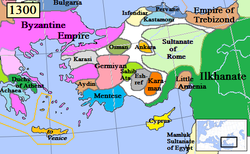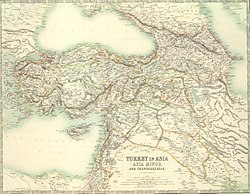Germiyanids
This article needs additional citations for verification. (September 2016) |
Germiyan | |||||||||
|---|---|---|---|---|---|---|---|---|---|
| 1300–1429 | |||||||||
 Beylik of Germiyan (light red) in 1300. | |||||||||
| Capital | Kütahya | ||||||||
| Religion | Muslim | ||||||||
| Government | Monarchy | ||||||||
| Bey | |||||||||
• 1300-1327 | Yakup I of Germiyan | ||||||||
• 1402-1429 | Yakup II of Germiyan | ||||||||
| Historical era | Late Medieval | ||||||||
• Established | 1300 | ||||||||
• Disestablished | 1429 | ||||||||
| |||||||||
The Anatolian beylik of Germiyan with its capital in Kütahya was one of the prominent frontier principalities established by Turkmens and Kurds after the decline of Seljuq Sultanate of Rûm.[1][2] According to Agoston and Masters Germiyanoğulları were Turkmens who had immigrated to the west because of Mongol pressure in the second half of the 13th century.[3]
For a brief period in the second half of the 14th century, Germiyan Dynasty was second only to Karamanid Dynasty in its rising power. But they were later taken over by the neighboring Osmanoğlu dynasty, who were to found the Ottoman Empire later.
Germiyans played a crucial role in settling Turkish populations along the coastal regions of the Aegean Sea, the founders of the Beyliks of Aydin, Sarukhan, İnançoğlu and Menteşe having started out as Germiyan commanders.
Because of various factors arising from the Mongol invasion, their branch of the clan had left the regions of Fars and Kirman, and headed west into Anatolia, having remained for a time around Malatya, and then moving to the Kütahya area, where their beylik was formed rather rapidly.
They rebelled against the central power in 1283, upon the execution of the sultan Kaykhusraw III by the Mongols, and placing of Mesud II on the Seljuq throne. The struggle between combined Mongol-Seljuq forces based in Konya and the rebel forces of Germiyan continued until 1290. An agreement could only be reached in 1299, upon which the Germiyan Dynasty also entered into possession of Ankara. When the Ilkhanid governor Emir Çoban took over Anatolia in 1314, they declared allegiance and concentrated on raids towards the regions to their west.
Their western offshoots that were the Beyliks of Menteşe, Aydin, Ladik, Sarukhan and Karasi were all subject to the Germiyan in the early periods of their foundation, while the Beyliks of Sâhib Ata and Hamidids to the south had to rely on them for protection against attacks from the Karamanids. As for the northern regions of Anatolia, Byzantine sources record Umur Bey, a commander and son-in-law to the Germiyan family, to be the possessor of Paphlagonia, where Jandarid dynasty was to rule only after Germiyan power weakened.
Their strong political entity was eventually surrounded by newer states established by their own former commanders, leaving the Germiyan no outlet to the coastline or to Byzantine territory. Their powerful Karamanid neighbors exerting constant pressure from the east, Germiyan gradually fell under the rising influence of the Ottomans.
The actual Turkish province of Kütahya was called the sub-province (sanjak) and later province (vilayet) of Germiyan until the early years of the Republic of Turkey, when which it was renamed after its central town.
The founding dynasty of the beylik produced descendants who illustrated themselves either under the Ottoman Empire or in present-day Turkey, a notable one among these being the 19th century grand vizier Abdurrahman Nureddin Pasha.
See also
| History of Turkey |
|---|
 |
| Timeline |
|
|
References
- ^ Peter Malcolm Holt, 1986, The Age of the Crusades: the Near East from the eleventh century to 1517, p. 176, Longman, University of Michigan, ISBN 0-582-49303-X, 9780582493032 The second of the eastern principalities, Germiyan, developed from a group, probably of mixed Kurdish and Turkish origin
- ^ Marios Philippides, Biblioteca apostolica vaticana - 1990, Byzantium, Europe, and the early Ottoman sultans, 1373-1513: an anonymous Greek chronicle of the seventeenth century, p. 6, A.D. Caratzas, University of Michigan, ISBN 0-89241-430-8, ISBN 978-0-89241-430-7, Near Byzantine borders in Phrygia, the emirate of Germiyan was formed by a mixed population of Turks and Kurds, who had come from east of Malatya
- ^ Gabor Agoston-Bruce Masters, Encyclopaedia of the Ottoman Empire, p. 41 ISBN 978-0-8160-6259-1
- (limited preview) Mehmet Fuat Köprülü (1992). The Origins of the Ottoman Empire ISBN 0-7914-0819-1. Translated by Gary Leiser. State University of New York Press.
